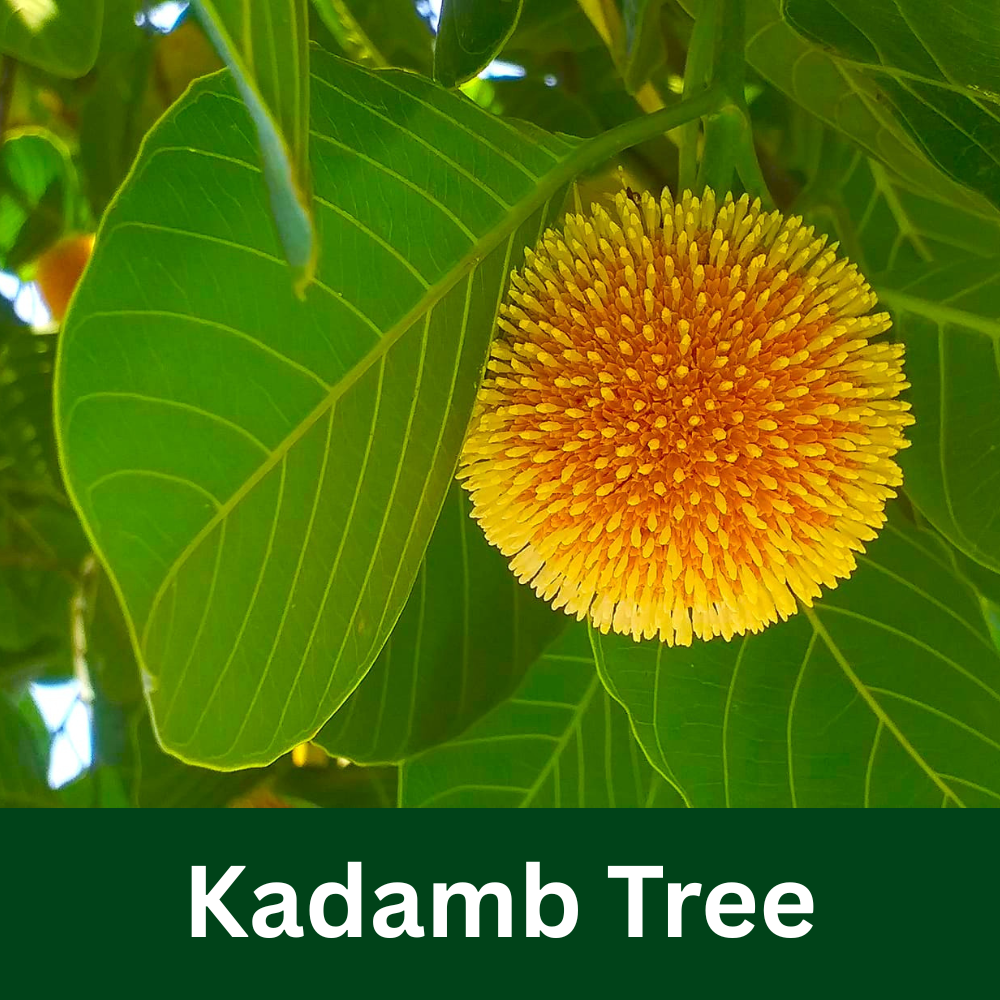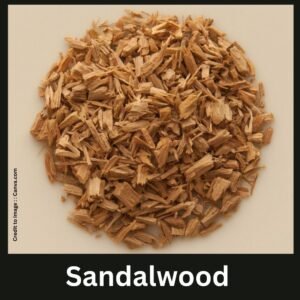The Kadamb Tree (Kadamba Tree) (Neolamarckia cadamba), popularly known as Kadamba or Bur-flower tree, is deeply rooted in India’s cultural heritage, Ayurveda, and ecological balance. Known as the favorite tree of Lord Krishna, the Kadamb holds a sacred place in mythology and is revered for its medicinal benefits, environmental value, and vastu significance. Scientifically, it belongs to the Rubiaceae family and has wide applications in traditional medicine, reforestation, and sustainable living. This article explores the botanical identity, mythological associations, medicinal benefits of Kadamb fruit and bark, environmental role, vastu uses, and its contribution to Sustainable Development Goals (SDGs).
Table of Contents
- Introduction: What is the Kadamb Tree (Kadamba Tree)?
- Scientific and Botanical Classification
- Kadamb Tree (Kadamba Tree) Meaning and Symbolism
- Kadamba in Indian Mythology and Culture
- Kadamba and Lord Krishna
- Kadamba as Parvati’s Tree
- Symbolism in Love and Literature
- Medicinal Benefits of Kadamb Tree (Kadamba Tree) Kadamb Bark and Leaves in Ayurveda
- Kadamb Fruit: Nutritional & Healing Properties
- Kadamb in Snakebite Remedies
- Kadamb in Modern Herbal Medicine
- Popular Ayurvedic Medicines Made from Kadamb (with brand references)
- Kadamba Tree Benefits for Environment
- Ecological Significance
- Kadamba in Reforestation and Climate Action
- Kadamba in Vastu Shastra & Home Planting
- Kadamb Tree and Sustainable Development Goals (SDGs)
- Summary
- FAQs (Questions & Answers)
- Conclusion
- References
1. Introduction: What is the Kadamb Tree (Kadamba Tree)?
The Kadamb Tree, also called Neolamarckia cadamba or Anthocephalus cadamba, is a fast-growing tropical tree native to South and Southeast Asia. Known as the Bur-flower tree due to its spherical yellow-orange flowers, it has significant religious, medicinal, and ecological value.
2. Scientific and Botanical Classification of Kadamb Tree (Kadamba Tree) :
- Common Name: Kadamba / Kadamb
- Scientific Name: Neolamarckia cadamba (syn. Anthocephalus cadamba)
- Family: Rubiaceae
- Other Names: Bur-flower tree, Kadam, Kadamba Vriksha
- Distribution: India, Bangladesh, Nepal, Myanmar, Thailand, Indonesia
Kadamb Tree (Kadamba Tree) Scientific Data Table
| Feature | Details (diagnostic/useful) |
| Family | Rubiaceae |
| Habit & size | Fast-growing, large tree, often ≤45 m with a straight, cylindrical bole; flowers from 4–5 years. |
| Leaves | Opposite, large (~13–32 cm), entire; cattle fodder use reported. |
| Flowers | Sweetly fragrant, red-orange, globose heads (~5.5 cm Ø); high cultural value. |
| Fruit | Multiple tiny fleshy capsules forming a yellow-orange infructescence; ~8,000 seeds per head reported. |
| Key bark/leaf compounds | Cadambagenic/quinovic acids, β-sitosterol, cadambine, quercetin glycosides, etc. |
| Reported bioactivities | Antioxidant, antifungal, antihelminthic, larvicidal, hepatoprotective, hypolipidemic, antidiarrheal (preclinical). |
3. Kadamb Tree (Kadamba Tree) Meaning and Symbolism
The meaning of the Kadamba tree goes beyond botany—it is a symbol of love, devotion, and harmony with nature. Its association with monsoon blossoms, Krishna’s flute songs, and Radha’s love makes it an eternal symbol in Indian culture.
4. Kadamba in Indian Mythology and Culture
Kadamba and Lord Krishna
The Kadamb tree is believed to be Lord Krishna’s favourite tree, under which he played the flute and performed the divine Rasa Leela with Radha and the Gopis.
Kadamba as Parvati’s Tree
In Hindu mythology, Goddess Parvati is believed to reside in the Kadamba tree, making it sacred for worship during certain festivals.
Symbolism in Love and Literature
Classical poets have described the Kadamb blossoms as symbols of romance, rain, and longing, especially in Sanskrit and Tamil literature.
5. Medicinal Benefits of Kadamb Tree (Kadamba Tree)
Kadamb Bark and Leaves in Ayurveda
- Used as an antipyretic (fever remedy)
- Relieves skin infections and ulcers
- Decoctions are used for digestive issues
🌟 Kadamb Fruit: Nutritional & Healing Properties
The Kadamb fruit is highly valued in Ayurveda for its cooling, detoxifying, and therapeutic properties:
- Rich in antioxidants – helps fight oxidative stress
- Supports liver health – used in jaundice remedies
- Improves digestion – relieves acidity and constipation
- Boosts immunity – enhances natural defense
- Promotes wound healing – applied in paste form for cuts
Scientific Data Table — Proximate & Mineral Composition of Kadamb Fruit (per 100 g fresh)
| Parameter | Value |
| Energy | ≈103.7 kcal |
| Protein | ≈2.1% |
| Fat | ≈2.4% |
| Key minerals (examples) | Fe ≈28.3 mg, Ca ≈123.7 mg, Zn ≈11.05 mg, Cu ≈4.19 mg, Mg ≈71.04 mg, K ≈36.7 mg, Na ≈10.7 mg, Mn ≈13.7 mg |
Kadamb in Snakebite Remedies
In traditional medicine, Kadamb extracts were used as an antidote to snakebites, especially in rural India.
Kadamb in Modern Herbal Medicine
Kadamb is being researched for anti-inflammatory, antimicrobial, and antioxidant properties, making it valuable in herbal formulations.
6. Popular Ayurvedic Medicines Made from Kadamb
Several reputed Ayurvedic brands use Kadamb in their formulations:
- Dabur’s Ayurvedic Liver Tonic – supports liver health.
🔗 Dabur Ayurveda - Baidyanath Kadamb Churna – used for digestive and skin disorders.
🔗 Baidyanath Ayurveda - Himalaya Herbal Supplements – incorporates Kadamb extracts in wellness tonics.
🔗 Himalaya Wellness
7. Kadamb Tree (Kadamba Tree) Benefits for Environment
Ecological Significance
- Improves soil fertility through leaf litter
- Supports pollinators and birds with nectar-rich flowers
- Provides shade and cooling effect in hot climates
Kadamba in Reforestation and Climate Action
- Used in afforestation drives due to fast growth
- Helps in carbon sequestration
- Strengthens ecosystem resilience in degraded lands
Kadamb Tree (Kadamba Tree) Ecological/Geographical Requirements
| Factor | Typical range/notes |
| Altitude | ~300–800 m (up to ~1,000 m near equator) |
| Mean annual temperature | ~23 °C; frost-sensitive |
| Rainfall | Thrives at ≥1,600 mm; generally 1,500–5,000 mm reported; locally tolerates much drier sites (~200 mm) |
| Light | Light-demanding, fast juvenile growth |
| Soils | Prefers well-drained entisols; avoid waterlogged, leached, poorly aerated profiles |
- Sources: CIFOR monograph; World Agroforestry (ICRAF) species sheet; additional wood-property studies.
- Production & plantation hotspots (global snapshot)
- There is no single global “fruit production” dataset for Kadamb like there is for mango or apple. What the literature does document is plantation and industrial use (timber/pulp) and active research by country.
Data Table — Leading countries for cultivation/plantations & industrial use (literature-based)
| Rank (qualitative) | Country | What’s notable |
| 1 | Indonesia | Widely planted as “white jabon”; large & smallholder plantations increasing for fast timber/pulp. |
| 2 | India | Native range, common in agroforestry and reforestation; cultural prominence and domestic timber/pulp use. |
| 3 | China (South) | Short-rotation plantations and growth/adaptability trials; regional timber programs. |
| 4 | Malaysia | Part of Southeast Asian native/managed forests; planted for plywood/pulp. |
| 5 | Thailand | Regional planting and wood studies; native distribution supports utilization. |
- Why not tons/ha? Centralized official production statistics by country are not consistently reported for Kadamb; literature offers qualitative/area indications and targeted trials rather than standardized national harvest data. Where numeric plantation areas exist, they’re typically regional or project-specific rather than comparable global totals. (Semantic Scholar)
8. Kadamba in Vastu Shastra & Home Planting
According to Vastu Shastra, planting a Kadamba tree brings:
- Prosperity and peace in the household
- Positive energy flow
- Protection against negative influences
9. Kadamb Tree and Sustainable Development Goals (SDGs)
The Kadamb tree is a holy tree which supports multiple UN SDG’s -Sustainable Development Goals:
- SDG 3 (Good Health): Through Ayurvedic medicines
- SDG 13 (Climate Action): Carbon absorption and cooling
- SDG 15 (Life on Land): Biodiversity support and reforestation
- SDG 11 (Sustainable Cities): Urban greening and pollution reduction
10. Summary
The Kadamb tree is more than a tree—it is a cultural icon, medicinal treasure, and environmental guardian. The Kadamb tree (Neolamarckia cadamba) is far more than just a botanical wonder—it is a cultural symbol, a medicinal treasure, and an ecological guardian. Rooted in Indian mythology, it is closely associated with Lord Krishna’s playful pastimes, Parvati’s grace, and the eternal love stories of Radha and Krishna, making it sacred in many traditions. Scientifically, Kadamb thrives in tropical and subtropical climates, with the highest production found in India and Southeast Asia.
Its fruits and bark hold immense medicinal value, widely used in Ayurveda and pharmacognosy for treating fever, skin disorders, digestive issues, and even snakebites. Modern studies confirm its antioxidant, anti-inflammatory, and antimicrobial properties, proving its relevance in both heritage medicine and modern research. With its large, shade-giving canopy, Kadamb also plays a vital ecological role by improving air quality, supporting biodiversity, and aiding reforestation projects, thereby contributing to the United Nations Sustainable Development Goals (SDGs) on climate action, good health, and life on land.
Today, Kadamb is not only revered in temples and literature but is also being rediscovered through Ayurvedic brands that harness its healing power in medicines and herbal formulations. Its deep roots in culture, science, and sustainability make the Kadamb tree a timeless gift of nature, carrying wisdom from the past while offering solutions for a greener, healthier future.
11. FAQs (15 Questions & Answers)
Q1. What is the Kadamba tree?
It is a fast-growing tropical tree (Neolamarckia cadamba). Valued in mythology, Ayurveda, and ecology and also support SDGs .
Q2. Why is the Kadamba tree sacred?
It is associated with Lord Krishna’s Rasa Leela and Goddess Parvati.
Q3. Write the scientific name of the Kadamb tree?
Neolamarckia cadamba (syn. Anthocephalus cadamba).
Q4. What is Kadamba tree meaning in Hinduism?
It symbolizes love, devotion, fertility, and divine blessings.
Q5. Where is the Kadamba tree found?
India, Nepal, Bangladesh, Myanmar, and Southeast Asia.
Q6. Write about the medicinal uses of Kadamb bark?
Treats fever, ulcers, digestive issues, and skin diseases.
Q7. What are the benefits of Kadamb fruit?
Kadamb fruit is useful in liver health, immunity, digestion and wound healing etc , having multiple nutritional and antioxidant qualities.
Q8. Is Kadamb used in Ayurveda?
Yes, widely used for herbal medicines and tonics.
FAQs (Questions & Answers)
Q9. Can Kadamb tree be planted at home?
Yes, as per Vastu, Kadamb Tree brings prosperity and positive energy.
Q10. How does Kadamb tree help the environment?
It absorbs CO2, improves soil, and supports biodiversity.
Q11. What is the Kadamb tree flower called?
Bur-flower, a yellow-orange spherical bloom.
Q12. What is the connection between Kadamba and Krishna?
Krishna played the flute and danced with Radha under Kadamba trees.
Q13. Which Ayurvedic brands use Kadamb?
Dabur, Baidyanath, Himalaya, among others.
Q14. Does Kadamb tree support SDGs?
Yes, particularly health, climate, biodiversity, and urban sustainability goals.
Q15. Is Kadamb tree good for reforestation?
Yes, due to its fast growth and ecological resilience.
12. Conclusion
The Kadamb tree is a timeless blend of spirituality, medicine, and ecology. Its mythological roots, Ayurvedic healing powers, and environmental contributions make it a living heritage of India. By planting and protecting Kadamb trees, we not only preserve tradition but also move towards a sustainable future aligned with global goals.
13. References
- Wikipedia – Neolamarckia cadamba
- Wisdom Library – Kadamba Tree
- Housing.com – Kadamba Tree Benefits
- CABI Digital Library – Kadamba Ecology
- Taylor & Francis Online, Semantic Scholar
- Religion Wiki – Kadamba Tree in Mythology
- Ayurvedic Brands: Dabur, Baidyanath, Himalaya
PRAKRITI DARSHAN-NATURE AND ENVIRONMENT MAGAZINE
Prakriti Darshan is a leading Hindi-language magazine and digital platform dedicated to raising public awareness on vital issues related to nature, biodiversity, climate change, sustainable development, and environmental conservation. This magazine represents a unique blend of science, society, and sensitivity—offering a common platform for researchers, students, NGOs, policymakers, nature lovers, and conscious citizens alike.
With thought-provoking articles, inspiring stories, environmental research, impactful projects, and policy perspectives, Prakriti Darshan is a transformative journey toward a greener and more sustainable future.
Let us come together to protect and preserve our planet for generations to come.
Join us in our mission to protect and celebrate the planet.
Click for more information
- Visit www.prakritidarshan.com for Free Magazine ,Free membership benefits ,offered price magazine @ Rs.1 or Rs.11 only and more ……
- 🎗️Sponsor Prakriti Darshan Magazine – Support our environment mission.
- 📚 Explore the Environment Magazine – Read our latest and past issues.
- ✍️ Read Editor’s Article or Blog – Insightful thoughts from our editorial desk.
- 🌱 Join Membership – Be part of India’s leading green community.
- 🤝 Become an NGO Impact Story Partner – Share your grassroots impact nationwide.
- 🏢 Become a Company Partner – Showcase your CSR, ESG, or sustainability work.
- 👤 Become an Individual Partner – Volunteer, write, and raise your green voice.
- 📢 Advertise with Us – Reach eco-conscious readers across India.
- Eco Trails Newsletter
- Donate for “Hari Ho Vashundhara & Har school Hariyali “ Plantation campaign Associated Partner NGO :GDSS NGOwww.gdssngo.org
BALA DATT SHARMA,
MANAGING EDITOR ,
PRAKRITI DARSHAN-NATURE AND ENVIRONMENT MAGAZINE
- Drake Passage: The World’s Roughest Sea Route Between Atlantic and Pacific Oceans - August 22, 2025
- Top 10 Natural Parks in the USA: Biodiversity, Geography & Global Relevance - August 21, 2025
- Exploring the Best Natural Parks in USA: Biodiversity, Sustainable Tourism, and Role in SDGs - August 21, 2025







